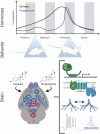Neural and Hormonal Control of Sexual Behavior
- PMID: 32845294
- PMCID: PMC7507403
- DOI: 10.1210/endocr/bqaa150
Neural and Hormonal Control of Sexual Behavior
Abstract
Gonadal hormones contribute to the sexual differentiation of brain and behavior throughout the lifespan, from initial neural patterning to "activation" of adult circuits. Sexual behavior is an ideal system in which to investigate the mechanisms underlying hormonal activation of neural circuits. Sexual behavior is a hormonally regulated, innate social behavior found across species. Although both sexes seek out and engage in sexual behavior, the specific actions involved in mating are sexually dimorphic. Thus, the neural circuits mediating sexual motivation and behavior in males and females are overlapping yet distinct. Furthermore, sexual behavior is strongly dependent on circulating gonadal hormones in both sexes. There has been significant recent progress on elucidating how gonadal hormones modulate physiological properties within sexual behavior circuits with consequences for behavior. Therefore, in this mini-review we review the neural circuits of male and female sexual motivation and behavior, from initial sensory detection of pheromones to the extended amygdala and on to medial hypothalamic nuclei and reward systems. We also discuss how gonadal hormones impact the physiology and functioning of each node within these circuits. By better understanding the myriad of ways in which gonadal hormones impact sexual behavior circuits, we can gain a richer and more complete appreciation for the neural substrates of complex behavior.
Keywords: activation; gonadal hormones; reproductive behavior; sex differences; sex hormones.
© Endocrine Society 2020.
Figures


References
-
- Forger NG, de Vries GJ, Breedlove SM. Sexual Differentiation of Brain and Behavior. In: Plant T, Zeleznik A, eds. Knobil and Neill's Physiology of Reproduction. 4th ed. Elsevier; 2015:2109-2155.
-
- Wallen K. Hormonal influences on sexually differentiated behavior in nonhuman primates. Front Neuroendocrinol. 2005;26(1):7-26. - PubMed
Publication types
MeSH terms
Substances
Grants and funding
LinkOut - more resources
Full Text Sources
Medical

